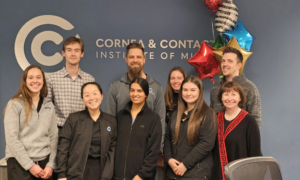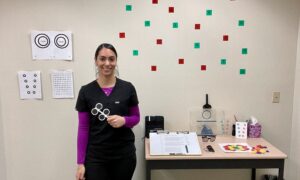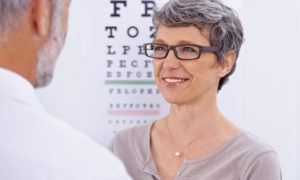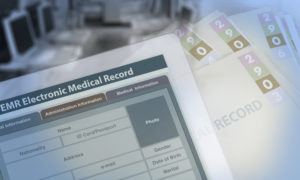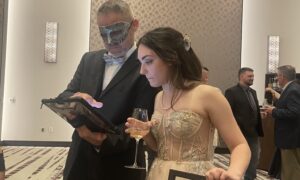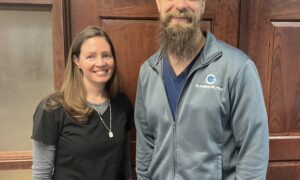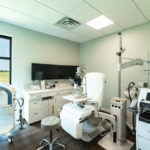
The room in Dr. McGee’s office, where she performs intense pulse light (IPL) treatments and offers other aesthetic optometry services.
By Selina R. McGee, OD, FAAO
Oct. 13, 2021
Aesthetic optometry is taking off. I project that within three years these services will comprise 30 percent of my practice’s revenues. Deciding which aesthetic optometry treatments you will add to your practice, and making the investments necessary to roll out those services to patients, is only half the work you need to do.
The other half is educating your patients about the availability of aesthetic optometry treatments in your office, and why they could benefit from some of the treatments you are now able to deliver.
Here are a few key conversations with patients that allow me to do that successfully, resulting in aesthetic optometry services that are experiencing 22 percent year-over-year growth.
Did You Know There Are Chemicals in Many of the Cosmetics You Use?
I ask patients: “Did you know that the U.S. only bans 11 chemicals while Europe bans over 1,300, and that the FDA hasn’t changed anything in the Cosmetic Industry Act since 1938?
This shocks people. They are surprised and even sometimes angry because they have been paying a lot of money for a label that means absolutely nothing.
I ask patients to start to review the ingredients in their products. The number one reason I talk about this is to educate my patients. I want them to see me as the authority on all things eyes (which I am, as are you as an optometrist). Once we have that conversation, then I can prescribe products that we carry in our office.
The cosmetic lines we provide in the office are Eyes Are the Story, Twenty-Twenty Beauty and Epionce. The ROI is typically 50 percent of the product, meaning our mark-up is 2x, so if we spend $30 on a product, then we sell it for $60. However, this investment in inventory to sell in the office is more about offering something to patients where I control the narrative–keeping them in my practice–rather than on direct profits from sales.
Don’t be intimidated by conversations with patients about the cosmetics they are using, and the possible negative impact of those cosmetics on their eyes. Patients are usually hungry for this type of information. Many people are highly interested in limiting the chemicals they are exposed to. That there may be chemicals in the products they use so close to their eyes is information many will likely act on, possibly by purchasing products in your office, or asking for procedures that would reduce the need for cosmetics in the first place.
Do You Want Your Eyes to Be More Open?
With the drop Upneeq now available, this is an awesome question to ask patients. They are excited to try a drop that can help with blepharoptosis.
Upneeq, a recently released prescription medication for acquired blepharoptosis, is also a prescription product available to our patients. Upneeq is an effective way to achieve results non-invasively for patients who want their eyes to have a more open look. Upneeq was among the products chosen for the Allure 2021 Best of Beauty Breakthrough Award. I offer samples of Upneeq, and have the patient try it while in our office. Be sure to place the drop in only one eye at first, so the patient can see the difference. When they love it, place a drop in the other eye to balance them.
Other Articles to Explore
Radiofrequency can be a more permanent, non-invasive solution to tighten lids and build collagen. However, in some cases, surgical options like a blepharoplasty or muellerectomy may be what’s needed for the patient.
For radiofrequency procedures, I have a TempSure by Cynosure. With my initial investment and maintenance contract, I need two patients per month to break even from this investment. To profit from it, I set a goal of one new patient weekly treated by use of this instrument.
Upneeq and radiofrequency procedures are value-added services that can improve patient satisfaction with their appearance and increase eye comfort. Giving patients the information that you can help with the appearance of their eyes reinforces the messaging to them that you are the expert in all things eyes.
Check First with Your OD State Board
We recommend checking with your state board and your professional liability insurance carrier to verify that these procedures (Intense Pulse Light (IPL), Radiofrequency (RF) and Neurotoxins/Botox) are permitted under the optometry laws and regulations of your state.–ROB Editors
Are You Interested In Reducing the Signs of Aging?
I ask this key question in the exam room: Do any of these bother you? Fill in the blank with droopy lids, pigment, eyelid bags, wrinkles, redness on their lids/eyes. Utilize a patient intake questionnaire that includes questions about eye-related cosmetic concerns.
This question opens up the conversation to what we may not be “seeing” with patients when we do an exam. Patients are often interested in how I can help them with each of the issues I listed for them.
My first recommendation to patients is removing ingredients from their routines that could be sabotaging their eye health. Then I talk to patients about how I can help them with their concerns. If it’s redness, the solution may be Intense Pulse Light (IPL). If it’s skin tightening, then I might recommend radiofrequency treatments. If it’s preventing dynamic wrinkles, then a good solution could be a neurotoxin such as Botox. If it’s turning back the clock, it’s laser resurfacing. Many times it’s a combined treatment approach.
For IPL treatments, I utilize a series of treatments for patients. With my initial investment and maintenance fees I needed one patient per week to break even. We now perform on average about 6-8 per week.
What to Ask on Intake Form
In addition to conversations with patients, I use an intake form, which you can download HERE, that includes questions related to aesthetic optometry services that patients could benefit from. This can be an easier way to “slide” into these conversations with patients so that it doesn’t feel awkward.–Selina R. McGee, OD, FAAO
The maintenance fees on instrumentation can often be more costly long term than the instrument itself, and is important to factor in when looking at pro forma. My yearly maintenance contracts for my RF and IPL add up to be over $20,000 annually. So, if I treat two patients per month, I break even.
We have a unique set of skills and tools that are being underutilized by our current and future patients. You can make patients aware of those unique skills and tools when talking to them in the exam room. Those conversations will help your patients, and can give you a springboard to launch or grow aesthetic optometry services in your practice.
 Selina R. McGee, OD, FAAO, is the founder of BeSpoke Vision in Oklahoma and is also vice-president of Intrepid Eye Societyand past-president Oklahoma Association of Optometric Physicians. To contact her:drmcgee@bespokevision.org
Selina R. McGee, OD, FAAO, is the founder of BeSpoke Vision in Oklahoma and is also vice-president of Intrepid Eye Societyand past-president Oklahoma Association of Optometric Physicians. To contact her:drmcgee@bespokevision.org

